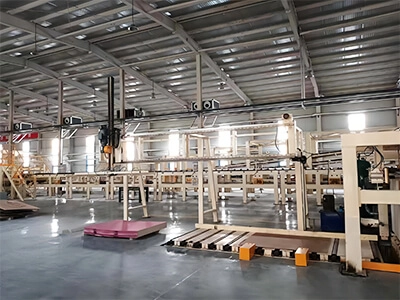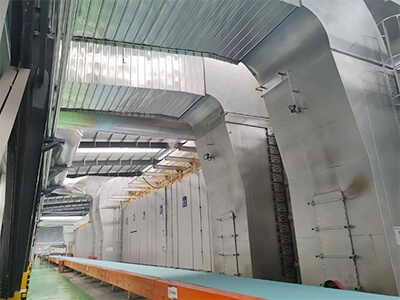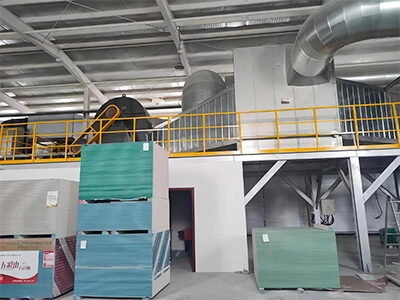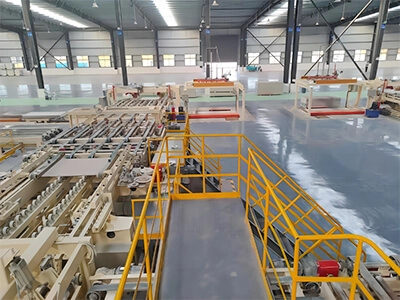
Gypsum Board Machine Factory

Paper Faced Gypsum Board Machinery

Produce Gypsum Board

Paper Faced Gypsum Board Production Line
Phosphogypsum is the phosphate fertilizer industry solid waste, and phosphoric acid is the foundation of phosphate fertilizer industry. WPA production of sulfuric acid decomposition through phosphate rock formation extraction slurry, and then filter cleaning system in the phosphorylation. In the process of washing filters at the same time have a phosphogypsum waste. Phosphogypsum generally is powder ,because contain 8-15% water ,so it is paste-like ,the particle diameter is generally 5-150 μ m, the main ingredients is CaSO4 • 2 H2O, it usually is 70-90 %, which contained elements of the secondary sources of ore vary, more complex ingredients are generally contain elements of rock, Ca, Mg phosphate, carbonate and silicate, In addition, a small amount of organic phosphorus, sulfur, fluorine compounds. Phosphogypsum general appearance of a gray, Hui Huang, light yellow, light green, and other colors, the relative density is 2.22 - 2.37, the capacity is 0.733 - 0.880 g/cm3.
Phosphogypsum is a by-product of ammonium phosphate production in phosphate fertilizer enterprises, mainly containing impurities such as fluoride, phosphorus pentoxide, and organic matter. It is highly acidic and has a pH value as low as 1.9. Research has shown that these harmful impurities are important factors leading to low comprehensive utilization rate of phosphogypsum. In order to achieve efficient utilization of phosphogypsum, it is necessary to research and develop new processes and equipment for impurity removal of phosphogypsum.
The main process for the disposal and reuse of phosphogypsum currently involves two steps: modification, impurity removal, and calcination.
Most of the calcination processes use traditional gypsum production processes and equipment such as double drum calcination kilns, fluidized bed calciners, fryers, rotary dryers, and drying crushers. The traditional gypsum
process is relatively simple (mainly based on the calcination of dihydrate gypsum into hemihydrate gypsum as the core), which cannot effectively remove harmful impurities in phosphogypsum, seriously restricting the comprehensive utilization of phosphogypsum.
This article introduces a new type of suspended air flow integrated treatment technology and equipment for phosphogypsum, providing a new technological approach for the resource utilization of phosphogypsum.
1. Traditional treatment process and equipment for phosphogypsum
The traditional gypsum treatment process is mainly classified into frying pans, rotary kilns, fluidized bed furnaces, and integrated grinding and calcination equipment according to equipment classification
Stir fryers, rotary kilns, boiling furnaces, etc. mainly use stacked or fluidized heat exchange methods, which have long dehydration time, high heat consumption, and low thermal efficiency; The integrated grinding calcination equipment is mostly air flow calcination equipment. Due to its advantages of simple process, high production efficiency, and low energy consumption, it has become the mainstream of current gypsum calcination equipment, with the disadvantage of unstable operation.
Most traditional phosphogypsum calcination production lines have extensive processes, rudimentary equipment, low technical level, low single line output, high energy consumption, and severe dust pollution, resulting in phosphogypsum bonding materials( β The quality performance (strength, setting time) of the semi hydrated gypsum powder cannot meet the production technical standards of downstream gypsum cementitious material products industry (such as paper gypsum board, gypsum strip board, fiber reinforced gypsum board, gypsum block, gypsum mortar, etc.), and the product performance is significantly inferior to natural gypsum and other industrial by-product gypsum products, thus unable to meet the large-scale promotion and application.
2. New treatment process and equipment for phosphogypsum
2.1 Process technology
Based on the complex material characteristics of phosphogypsum, a suspended airflow type phosphogypsum impurity removal, modification, and dehydration integrated treatment process has been proposed through research. The specific process flow is shown in Figure 1. The system mainly includes sequentially connected drying units, impurity removal units, phase change units, cooling units, and dust removal units. The characteristics of each unit are shown in Table 2.
2.2 Suspension calcination equipment for phosphogypsum
2.2.1 Unit composition of calcination system
1) The main equipment of the drying unit includes a pulse airflow dryer and a separator; The lower part of the pulse airflow dryer is equipped with a feeding port and a hot air inlet, and the top outlet is connected to a cyclone separator. The bottom of the cyclone separator is equipped with a discharge system; 2) The main equipment of the high-temperature impurity removal unit includes a impurity removal furnace, heat exchange air duct, exhaust air duct, and discharge system; 3) The main equipment of the phase change unit includes a phase change furnace, exhaust duct, and discharge system; 4) The main equipment of the cooling unit is a dense phase flow cooler; 5) The main equipment of the dust removal unit is a fan and a bag filter.
In addition, the system is also equipped with relevant monitoring and control, automatic adjustment units, such as online moisture/humidity monitoring instruments and weighing sensors at the feeding mouth of the drying unit, temperature and wind speed online detection instruments, temperature transmitters, and pipeline type air pressure transmitters at the hot air inlet (on the pipeline), which are convenient for the automation control of modern chemical plants.
2.2 System Key Equipment
The main equipment of this system is a drying unit separator, a high-temperature impurity removal unit impurity removal furnace, and a phase change unit phase change furnace, with the core equipment being the impurity removal furnace. The structure is composed of an outer cylinder with a 270 ° large eccentric volute shape, an inner cylinder, a guide plate, a cylindrical cylinder, and a conical cylinder from top to bottom. The air inlet is arranged on an eccentric volute shaped cylinder, with a narrow pentagonal structure at the lower section. The upper port of the inner cylinder is connected to the exhaust pipe
The structure of the impurity removal furnace has the following characteristics:
1) The spiral angle of the inlet air duct of the impurity removal furnace is increased to 270 °, which can balance the introduction of dust carrying gas into the cyclone tube, and the gas rotates at high speed along the tube wall to improve dust collection efficiency;
2) Increase the cross-sectional area of the inlet air duct and place it on the outer side of the inner cylinder to prevent gas from rushing towards the inner cylinder, resulting in increased pressure loss;
3) Due to the volute arrangement of the impurity removal furnace wall, it gradually approaches the inner cylinder, so the airflow will not be obstructed;
4) The height h of the inner tube is 1/2 of the height b of the inlet air duct, which can reduce pressure loss. At the same time, the spiral lower part of the inlet air duct is designed as a diagonal cone, which happens to start from the lower end of the inner tube, so that the dusty airflow does not directly enter the inner tube and does not affect the dust collection efficiency;
5) The conical part of the impurity removal furnace is designed to be twice the diameter of the inner cylinder, with an inclined angle β By increasing the outlet size to 70 °, the material continuously enters the discharge pipe, preventing production interruption caused by blockage;
6) The ascending air duct entering the transition zone of the impurity removal furnace eliminates all horizontal planes, prevents internal ash accumulation, and also eliminates material erosion on its inner wall, ensuring uniform airflow movement
7) To avoid dust accumulation and increase resistance, the bottom of the spiral intake duct is made into a slope, with the angle of the slope α 50 °;
8) The basic parameter for the design of the impurity removal furnace is the diameter D of the cylinder, which is determined by the calculation of the air volume processed by the system;
9) The height H of the impurity removal furnace is also an important parameter, which determines whether the material in the airflow has sufficient settling time and is also related to the dust collection efficiency;
10) Except for the miscellaneous furnace design, other parameters such as the position size L of the air inlet pipe are determined by the width of the annular cavity between its inner diameter D and the inner cylinder diameter d, as well as the width a of the air inlet;
11) The entire system should also be equipped with corresponding refractory and insulation materials to protect the equipment according to the material and working temperature of different parts of the equipment.
3. Advantages of Process System
Compared with existing phosphogypsum engineering application technologies, this integrated device has the following advantages:
1) Wide range of adaptation. This new type of phosphogypsum suspension calcination treatment process and equipment integrates the drying, modification, impurity removal, calcination, cooling and other processes of phosphogypsum, which can meet the requirements of different physical properties (wide range of feed moisture, block, granular, etc.) to process qualified phosphogypsum β Requirements for semi hydrated gypsum binder.
2) High thermal efficiency. Placing phosphogypsum in a closed high-temperature and high-speed turbulent hot gas flow, it is quickly mixed with high-temperature carrier gas to form a suspended state. By utilizing the characteristics of large contact area, high heat transfer coefficient (>80%), and short dehydration time of the gas-solid two-phase in the suspended state, it can conduct heat exchange at an extremely fast speed, complete thermal operations such as removing surface water (attached water), impurity removal modification, suspended air flow calcination, and promote the complete neutralization reaction, It is very suitable for the strong thermal sensitivity of gypsum.
3) Low system maintenance cost and high equipment operation rate. The main core part of the system has no moving components. After the material is fully mixed with high-temperature carrier gas to form a gas-solid mixture, dehydration, phase change, gas-solid separation, cooling and other process operations are completed in closed pipelines and containers; The high-temperature zone in the system is equipped with refractory materials, and the cooling unit adopts the principle of solid particle dense phase transportation and plate heat transfer technology, with integrated heat transfer simulation software. The system also fully considers individual blockage phenomena that may occur during operation and debugging, and is specially equipped with emergency discharge valves and discharge devices for blockage.
4) Energy saving. This system fully considers the cascade utilization of energy, first introducing the hot medium after high-temperature impurity removal to the surface water removal unit; Then, the remaining heat after gas-solid separation is sent to a phase change furnace for calcination (removing one half crystalline water); The energy cascade utilization not only considers the specific requirements of high-temperature impurity removal in phosphogypsum, but also is very suitable for the temperature sensitivity (calcination) requirements of phosphogypsum, achieving a perfect unity between energy cascade utilization and process technology requirements; The cooling unit has no moving parts and adopts a cooling water circulation cooling process, saving energy and improving equipment operation rate.
5) High system integration, small footprint, and high single line production capacity. The entire system has a compact process layout from top to bottom, with a small footprint. After using suspension calcination, it has the same characteristics as the calcination process of the new dry cement production line, such as high yield and stable product quality and performance.
6) The working environment is good, achieving clean production. The new process of suspended calcination of phosphogypsum integrates all necessary processes into a closed system. During operation, the system operates under negative pressure, without any dust leakage or dust emission, truly achieving clean production.
7) High level of automation. The key process points in the system are equipped with automated process detection devices, which monitor the changes in process parameters at each point in real time and automatically adjust process operating parameters in a timely manner, facilitating the realization of industrial production and automated control.